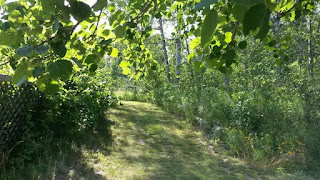What kind of plant and wildlife community do you live in? The communities in North America are:
Pacific coast forest, Sierra-Cascade forest, Rocky Mountain forest, Pinyon-Juniper woodland, Northern Coniferous forest, Sphagnum Bog, Eastern Mixed forest, Oak-Hickory forest, Southern Appalachian forest, Abandoned field, Southern Pine Forest, Cypress Swamp, California Oak Woodland, Chaparral Country,Sagebrush desert, cactus desert, Great Plains grassland, Tallgrass prairie, Alpine Meadow and Tundra, Arctic Tundra, Lake and Pond, Freshwater Marsh, Swift stream, Slow Moving water, Tidal Marsh, Mangrove Swamp, Pacific sandy shore, Eastern sandy shore, Rocky Pacific Coast and Northeastern coast.
In the area that we live in there are several types of plant and wildlife communities.
The first would be the Northern Coniferous Forest. We would be on the south edge of this type of community as the glaciers formed the great lakes and Michigan and this community is known by its expanses of evergreen trees.
The wildlife that is found in this type of community is: Beaver, red squirrel, snowshoe hare, mink, grey wolf, lynx, grouse, woodpecker, Jay, chickadee, nuthatch, warblers, crossbill, grosbeaks, junco and sparrows. Plant life would include Tamarack, spruce, fir, etc.
Another area that we are on the edge of would be the Sphagnum Bog. There are several around us.
They occupy glacial depressions. Some animal life in the bogs near here may be flycatchers, jays, wrens, thrush, waxwing, etc. And some plant life would include: spruce, tamarack, cedar, cranberry,
etc.
We are on the western edge of the Eastern Mixed forest region.
Spruces and conifers begin to mix with broadleaf maples and beeches.
Wildlife found in these areas would include: squirrels, chipmunks, raccoons, foxes, bobcat, hawk, grouse, woodpecker, flycatcher, jay, chickadee, titmouse, thrush, and warblers. Plant life may include:
pines, hemlocks, beech, basswood, maple, witch hazel, mayapple, bloodroot, dutchmans breeches, jack in the pulpit and trillium.
One of the most common communities in our area is the abandoned field. This is an area that had previously been disturbed by logging or farming or some other type of disturbance, and is now beginning to revert back to wild.
The first plants to show up are plants like lambs quarters milkweed, thistles, and nitrogen fixing plants. The soil is damaged and needs to be fed by these opportunistic plants. This is called the old field stage.
Soon shrubs and vines and small trees begin to sprout in the protected areas, being brought in by wind, animals and birds. Generally this land will attempt to go back to the type of community it was before it was damaged.
Animals that enjoy this type of community are: woodchuck, cottontail, deer, killdeer, bobwhite, dove,lark, mockingbird, bluebird, bobolink, goldfinch, towhee, and sparrows.
Plants that show up in these areas are: pines, cedar, juniper, birch, aspen, cherry, sumac, brambles,
queen annes lace, milkweed, mullien, aster, ragweed, black eyed susan, yarrow, and thistles.
We have a large old field to our east on Joel's corner that is part marsh and part old field. It is now being colonized by a group of pine trees and some small shrubs.
Another common Michigan area is the Lake and Pond area. We have put a small pond on our property so we have included some of this community in our grouping.
We occasionally have geese and ducks, we have herons and of course frogs and turtles in the pond, but it also draws the other wildlife to itself for drinking the water.
We have water lilies, pondlilies, willow, pondweeds, and cattails as well as many other pond plants since we have grown this habitat.
We also have some freshwater marsh on the property. We don't access it as much as the more open areas as it is difficult to go into without causing damage.
This area has animals such as muskrat, raccoon, cranes, snipesm hawks, blackbirds, (as does our pond).
The plants that are often found in these areas are: pondlily, water marigold, mallow, pennywort, speedwell, arrowhead, rushes, bulrushes, reedgrass, sedge, cattails, etc.

It is really quite an interesting study in recognizing what would be growing naturally in your area if it had not been disturbed. Oftentimes the seeds are still in the ground laying dormant trying to grow back if you just allow them to. The top photo shows at a distance the oldfield area where we have pines growing back on their own. They are seeding themselves. The center photo is of the pond we built after our housefire, which we have allowed nature to plant in the most part, however I have also planted some water lilies and some perennials like siberian iris. The woodsy photograph above used to be a horse pasture and grew back into a woods on its own. There is one very ancient aspen tree in the center of our rear woods, you can't get your arms around it if you have two people holding hands, it is huge. Some day I'll post a photo of it on here. It would likely be the mother tree of all of the aspens on this property. If you read about aspens, they grow from underground runners, and generally begin from a mother tree. The one root system can cover many acres.
We also have alder, wild cherry, ash, maples and oaks growing naturally in this area, and shrubs such as dogwood and brambles.
Look around you and find out what communities are in your neighborhood.

















































